.
Milos (in Greek, Μήλος, classic Greek: Μῆλος – Melos, Doric Greek: Μάλος – Malos), is a volcanic Greek island in the Aegean Sea, just north of the Sea of Crete. Milos is the southwesternmost island in the Cyclades group.
The island is famous for the statue of Aphrodite (the "Venus de Milo", now in the Louvre), and also for statues of the Greek god Asclepius (now in the British Museum) and the Poseidon and an archaic Apollo in Athens. The Municipality of Milos also includes the uninhabited offshore islands of Antimilos and Akradies. The combined land area is 160.147 km² and the 2001 census population was 4,771 inhabitants.
History
"Aphrodite of Milos"
Obsidian from Milos was a commodity as early as 13,000 years ago. Milos natural glass used for razor sharp "stone tools" was transported well before farming began and later: "There is no early farming village in the Near East that doesn't get obsidian".[1] The material was transported for thousands of miles.
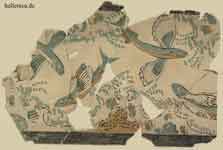
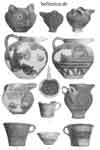
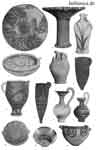
The position of Milos, between mainland Greece and Crete, and its possession of obsidian, made it an important centre of early Aegean civilization. Milos lost its arms-making importance when bronze became the preferred material for the manufacture of weapons.[2]
At the Bronze Age site of Phylakopi (Greek Φυλακωπή), the chief settlement, on the north-east coast, excavations by the British School of Archeology revealed a town wall and a Minoan palace with some important and very interesting wall paintings. "The famous fresco of the flying fish[3] found in the ruins of the principal house or palace at Phylakopi, with its delicate coloring and graphic observation of nature in the graceful movement of the fish, seems to be the work of a Cretan artist, who probably was summoned to Milos for the purpose."[4] Part of the site has been washed away by the sea.
The antiquities found were of three main periods, all preceding the Mycenaean age of Greece. Much pottery was found, including examples of a peculiar style, with decorative designs, mostly floral, and also considerable deposits of obsidian. There are some traditions of a Phoenician occupation of Milos.
"Antonio Vassilacchi was a Greek Artist born on Milos in 1556[5]".
In historical times, the island was occupied by Dorians from Laconia. In the 6th century BC, it again produced a remarkable series of vases, of large size, with mythological subjects and orientalizing ornamentation, and also a series of terra-cotta reliefs (Melian Reliefs).

115 : Head of a Kouros, Naxian marble

235 : Statue of Poseidon. Parian marble.

3990 Part of a disc. Island marble. Found on Melos.
Conflict with Athens
See also: The Melian Debate
The Greek historian Thucydides wrote in his History of the Peloponnesian War of how, in 416 BC, Athens attacked Melos for refusing to submit tribute and refusing to join Athen's alliance against Sparta.
The invasion of Melos occurred during the second phase of the Peloponnesian War (431 to 404 BC). The Melians claimed Spartan descent but had remained neutral throughout this conflict.[2] In 426 BC, Athens had prosecuted a brief perfunctory operation on the island but had withdrawn quickly because they were at the time involved in open conflict with Sparta. In 425 BC Athens claimed suzerainty over Melos and had demanded tribute.[6] The second attack on Melos occurred five years after Athens and Sparta had signed a peace agreement and some historians like Bosworth believe that Athens' campaign against Melos in 416 BC was motivated by imperial expansion.[6]
In the summer of 416 BC the Athenians landed an army of over 3,000 soldiers on the island, led by the generals Cleomedes and Tisias. They sent diplomats to negotiate a surrender, offering to spare the Melians if they joined the Athenian-dominated Delian League and paid tribute to Athens. The Melians rejected the ultimatum. The Athenians laid siege to the city and withdrew most of their troops from the island to fight elsewhere. For months the Melians withstood the siege, but with reinforcements from Athens and the help of traitors within Melos, the Athenians took the city that winter. In the aftermath, as was common in ancient history with resisted sieges, the Athenians executed all the adult men they caught, and sold the women and children into slavery. They then settled 500 of their own colonists on the island.[7]
When Athens was defeated by Sparta at the end of the Peloponnesian War, the Melian survivors, who had been resettled by Sparta, was restored to their homes by the Spartan general Lysander.
Milos in the Common Era
During the Frankish period the island formed part of the Duchy of Naxos, except for the few years (1341–1383) when it was a separate lordship under Marco Sanudo and his daughter.
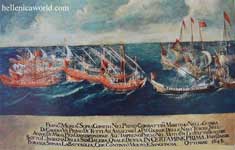
Battle of Milos, October 1645 ,
Geography
Milos, Kimolos (north), Polyaigos (East), Antimilos (west)
The Steep Beach of Tsigrado
The tallest peak of Milos Island (2,440 feet high).
The bay of Milos.
Aerial view of Milos Island from Prophet Elias at the top of the peak. (2,440 feet high)

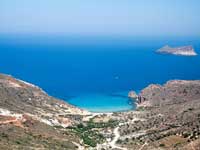
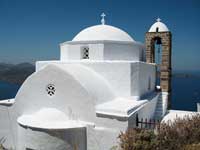
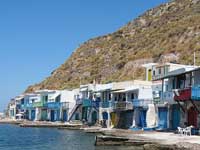
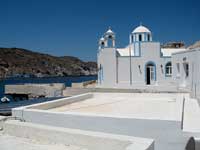
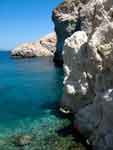
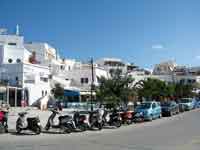


Milos is the southwesternmost island in the Cyclades, 120 km (75 mi) due east from the coast of Laconia. From east to west it measures about 23 km (14 mi), from north to south 13 km (8.1 mi), and its area is estimated at 151 km² (58.3 mi²). The greater portion is rugged and hilly, culminating in Mount Profitis Elias 748 m (2,454 ft) in the west. Like the rest of the cluster, the island is of volcanic origin, with tuff, trachyte and obsidian among its ordinary rocks. The natural harbour is the hollow of the principal crater, which, with a depth diminishing from 70 to 30 fathoms (130–55 m), strikes in from the northwest so as to separate the island into two fairly equal portions (see photo), with an isthmus not more than 18 km (11 mi) broad. In one of the caves on the south coast, the heat from the volcano is still great, and on the eastern shore of the harbour, there are hot sulphurous springs.
Antimelos or Antimilos, 13 miles (21 km) north-west of Milos, is an uninhabited mass of trachyte, often called Erimomilos (Desert Milos). Kimolos, or Argentiera, 1.6 km (0.99 mi) to the north-east, was famous in antiquity for its figs and fuller's earth, and contained a considerable city, the remains of which cover the cliff of St. Andrew's. Polyaigos (also called Polinos, Polybos or Polivo — alternative spelling Polyaegos) lies 2 km south-east of Kimolos. It was the subject of dispute between the Milians and Kimolians. It is now uninhabited.
The harbour town is Adamantas; from this there is an ascent to the plateau above the harbour, on which are situated Plaka, the chief town, and Kastro, rising on a hill above it, and other villages. The ancient town of Milos was nearer to the entrance of the harbour than Adamas, and occupied the slope between the village of Trypiti and the landing-place at Klima. Here is a theatre of Roman date and some remains of town walls and other buildings, one with a fine mosaic excavated by the British school at Athens in 1896. Numerous fine works of art have been found on this site, notably the Aphrodite in Paris, the Asclepius in London, and the Poseidon and the archaic Apollo in Athens. Other villages include Triovasalos, Peran Triovasalos, Pollonia and Zefyria (Kampos).
Natural resources
Bentonite, perlite, pozzolana and small quantities of kaolin are actively collected via strip mine or open-pit mine techniques in Milos and sold all over the world. In the past, baryte, sulfur, millstones and gypsum were also mined; in fact, Pliny notes that Milos was the most abundant source of sulfur in the ancient world.[8] In ancient times the alum of Milos was reckoned next to that of Egypt (Pliny xxxv. 15 [52]). The Melian earth was employed as a pigment by ancient artists. Milos was a source of obsidian during the Neolithic ages for the Aegean and Mediterranean. Orange, olive, cypress, tamarisk, juniper (Juniperus oxycedrus) and arbutus trees grow throughout the island, which, however, is too dry to have any profusion of vegetation. Vines, cotton and barley are the main crops.
The beaches of Milos Island
There are about 70 beaches on Milos Island. Hivadolimni Beach is the longest at about 1 kilometre (0.62 mi). The rest of the beaches are starting from (North): Sarakiniko Beach, Papafragas, Kapros, Pachena, Alogomantra, Konstantinos, Mitakas, Mantrakia, Firopotamos, Nerodafni, Lakida, Plathiena, Fourkovouni, Areti, Pollonia, Gourado and Filakopi. (South): Firiplaka, Paliochori, Provatas, Tsigrado, Agia Kyriaki, Psaravolada, Kleftiko, Gerontas, Gerakas, Agios Sostis, Mouchlioti, Katergo, Spathi, Firligos, Pialothiafes, Kalamos, Krotiraki, Psathi, Svoronou and Sakelari. (West): Agios Ioannis, Cave of Sikia, Agathia, Triades and Ammoudaraki. (East): Voudia, Thalassa, Paliorema, Tria Pagidia and Thiafes. (In the Bay Area): Hivadolimni, Lagada, Papikinou, Fatourena, Klima, Skinopi and Patrikia. The North and South and the bay beaches are tourists attraction. The east beaches are very quiet and the west are also quiet and lonesome beaches.
Demographics
Historical population
Year Island population
1907 17,638
1991 4,390
2001 4,771
Notable people
Antonio Vassilacchi (1556–1629), a painter
Diagoras (5th century BC), a philosopher
See also
Aegean Islands
List of Aegean Islands
Sarakiniko Beach
Milos Island National Airport (MLO)
Antimilos
Kimolos
References
^ C. Renferew
^ a b Chalk and Jonassohn, 65
^ Flying fish
^ CAH pg. 448
^ Gould, John (1838). Biographical dictionary of painters, sculptors, engravers, and architects, from the earliest ages to the present time: interspersed with original anecdotes, Volume 2. Greenland. p. 577. OCLC 261336841. "VASSILACCHI, called L'ALI- ENSE (Antonio), a Greek historical painter, born at Milo, a Greek island in the Venetian territory, in 1556, and died in 1629"
^ a b Dinah L. Shelton, www.enotes.com
^ Thucydides. History of the Peloponnesian War, Chapter 17.
^ C.Michael Hogan. 2011. Sulfur. Encyclopedia of Earth, eds. A.Jorgensen and C.J.Cleveland, National Council for Science and the environment, Washington DC
Notes
This article incorporates text from a publication now in the public domain: Chisholm, Hugh, ed (1911). Encyclopædia Britannica (11th ed.). Cambridge University Press.
I.F. Stone, 1988, The trial of Socrates, Anthos.
Cambridge Ancient History, Vol.II, 1924, New York, MacMillan
Colin Renfrew and Malcolm Wagstaff (editors), 1982, An Island Polity, the Archaeology of Exploitation in Melos, Cambridge, Cambridge University Press.
Colin Renfrew (editor), 1985, The Archaeology of Cult, the Sanctuary at Phylakopi, London, British School at Athens and Thames & Hudson.
Leycester, "The Volcanic Group of Milo, Anti-Milo, &c.," in Jour. Roy. Geog. Soc. (1852).
Tournefort, Voyage.
William Martin Leake, Northern Greece, iii.
Anton von Prokesch-Osten, Denkwürdigkeiten, &c.
Bursian, Geog. von Griechenland, ii.; Journ. Hell. Stud, xvi., xviL, xviii., Excavations at Phylakopi; Inscr. grace, xii. iii. 197 sqq.;
on coins found in 1909, see Jameson in Rev. Num. 1909; 188 sqq.
"Mílos". Global Volcanism Program, Smithsonian Institution. Retrieved 2009-01-01.
Seaman, Michael G., "The Athenian Expedition to Melos in 416 B.C.," Historia 46 (1997) pp. 385–418.
Chalk, Frank; Jonassohn, Kurt (1990). History and Sociology of Genocide: Analyses and Case Studies. New Haven: Yale University Press. pp. 65–66. ISBN 0-300-04445-3.
Bosworth, A.B. (2005). ""Athens and Melos." Genocide and Crimes Against Humanity ed. Dinah L. Shelton.". Gale Cengage, enotes.com. Retrieved 26 September 2009.
Connor, W. Raymond (1984). Thucydides. Princeton: Princeton University Press. p. 151.
Thucydides (1954). The Peloponnesian War. Harmondsworth: Penguin Books.
| Ancient Greece
Science, Technology , Medicine , Warfare, , Biographies , Life , Cities/Places/Maps , Arts , Literature , Philosophy ,Olympics, Mythology , History , Images Medieval Greece / Byzantine Empire Science, Technology, Arts, , Warfare , Literature, Biographies, Icons, History Modern Greece Cities, Islands, Regions, Fauna/Flora ,Biographies , History , Warfare, Science/Technology, Literature, Music , Arts , Film/Actors , Sport , Fashion --- |
Retrieved from "http://en.wikipedia.org/"
All text is available under the terms of the GNU Free Documentation License


